Not all reports this month have been happy ones and anglers have struggled at times. The final days of September were more or less washed away by heavy rain and floods. Before the rivers completely blew out on that occasion, Stuart Macoustra caught a brace of salmon, 8 and 10 pounds, from the bottom of the Usk at Newbridge. He was using a large Cascade tube and the Chainbridge gauge was then at 0.75, the colour fining down. Dan White had a cock salmon of 8 pounds spinning with a Flying C at Crickhowell. Meanwhile a party of 5 French anglers led by PD Maltot fished the Abergavenny Town Water for 11 trout, mostly taken on dry fly, and filmed a family of otters frolicking. High water is when you have a very good chance of seeing otters by day. PMG from Chingford was on the Wye at Fownhope 5: “…in the lashing rain I had 14 chub, all to feeder & boilie.”
With my own client for the day very keen to have a go for grayling despite the water levels, we fished the upper Wye at Abernant on the 26th. The river was dirty, strewn with drifting logs and rising from 2ft on the Llanstephan gauge eventually to 3 feet and really quite hopeless. The showers at this time were very strong but localised and capricious, saturating one valley and leaving the adjoining one dry. In fact on that day the coloured flood water was coming down from the Irfon and Ithon, while the main Wye above the junctions was still clear. However, all the main river beats up there were booked! On the lower river the chub and barbel anglers pressed on in the floods of course, relying on a quarry which hunts its food by smell, but in general the catches were reduced.
“It turns out that obsessively looking at the river level gauges will not make a flood disappear.” This from JT of High Wycombe, who had been hoping to fish for trout at Dinas on the 27th. How very true! SS from Manchester with a friend reported three sea trout from the Usk at Glan yr Afon, which was interesting. Then on the 29th, SH from Petersfield reported two sea trout shoalies of about a pound each from Chainbridge while salmon fishing: “I did not know the Usk was well known for sea trout.” Well it isn’t so much, but sea trout are not unknown in this river either. The last I can remember were a brace I took with a Willie Gunn while fishing one of the pools of Fenni Fach for salmon in a backend flood. SH’s fish were sea-liced, which should remove any doubt.
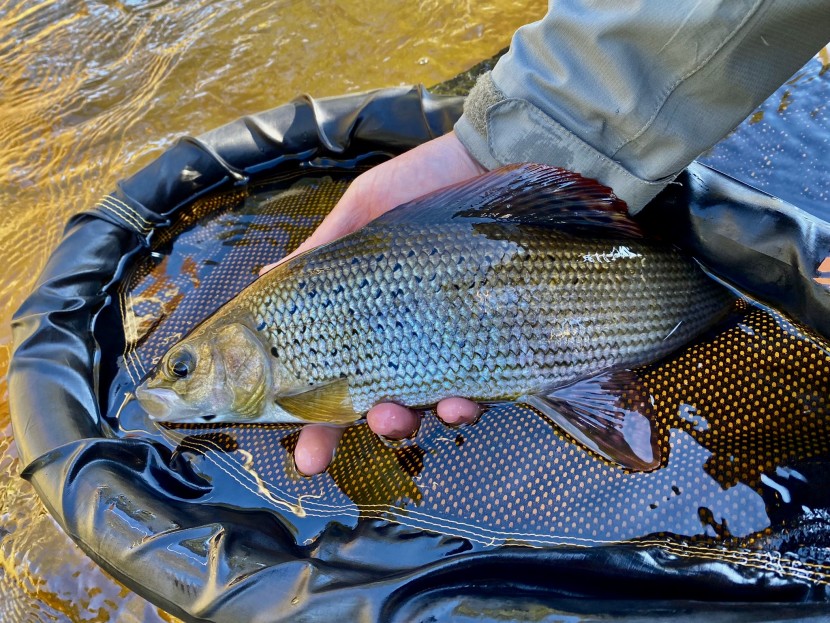 Craig Llyn grayling - Lyn Davies
Craig Llyn grayling - Lyn Davies 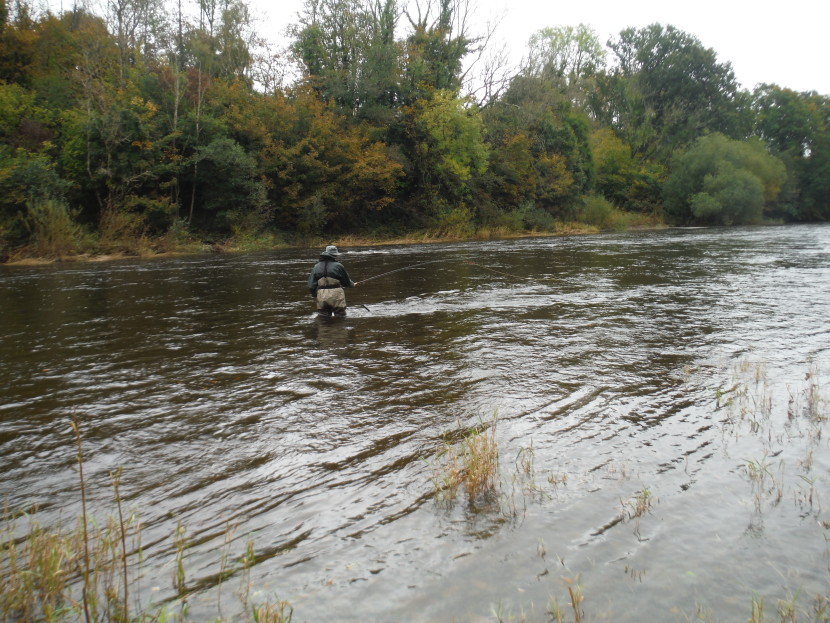 High water at Llangoed
High water at Llangoed RG from Preaux Bocages with his party of 4 French anglers went up to the Beacons Reservoir and caught 10 trout. RG’s report didn’t mention the matter directly, but he sent in a photograph of rubbish lying on the shore which really should put local anglers to shame. Here it is. I hope our readers aren’t responsible for any of that. Meanwhile, another of those special reports about fishing the Usk Reservoir came from EE of Ammanford which I will quote verbatim: “Used to be very good fishing here now not so much i fished 10 hours there today and all I had to show for it was a perch and a small brown trout definitely not worth the money I paid to fish there, last time was there very similar fishing too, years ago it was great I loved going there it’s a shame, there seems to be a lot of Europeans there who were laughing telling me that they never pay to fish there which is a concern.” I am tempted to ask whether these were Welsh Europeans or English Europeans, but I suppose I had better not. However, I will ask EE that if he thinks he saw poaching, what did he do about it at the time? Did he call the police or alternatively the water company? I hope so because doing nothing at the time and filing a discontented report afterwards is not particularly useful when combatting illegal fishing or any other kind of theft. On the same day at the same fishery, EB from Wiltshire caught 2 browns and 1 rainbow spinning with a black and orange spoon.
WM from Stroud was fishing the lower Wye at Middle Hill Court. Although the river was rising and brown he managed 8 barbel to 31 inches and lost several heavy fish. JC from Harpenden with a friend caught a brace of barbel at the Home Fishery, while the river rose 2 metres during the day. A day later they were on the Home Fishery, this time with the river falling. They caught 14 barbel to 9 pounds and 2 chub. RC from Worcester reported of the Eastern and Western Cleddau fishery: “Tough going. Clearly very polluted.” It would be good to understand from RC the reason for the second statement. What did he see? AC from Plymouth with an elderly relative was disappointed that they were unable to fish for salmon when they arrived at Upper Bigsweir on the 29th. This was an unfortunate trip because in fact there was no question of wading or fly fishing Upper Bigsweir on the 29th. The lower Wye was already in full muddy flood as the website gauge should have made clear. Also, once you have received your ticket and the pack of directions, do download or print them, make any needed calls and obtain any lock codes or other advice right away. Standing in the rain in front of a locked gate without a phone signal on the day is not the best time to get these details. However, I gather these anglers went on to have some decent sport at the local rainbow trout fishery at Big Well, which is good to hear.
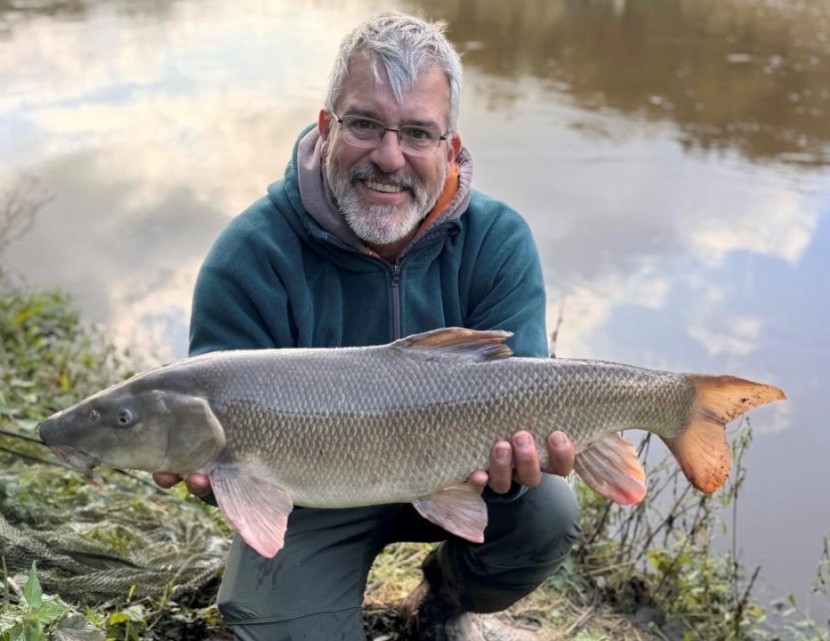 Courtfield - JC from Oxford
Courtfield - JC from Oxford Rather similarly CA from Barry was disappointed with the directions for Courtfield: “Not much information at all on the swims and no clear directions on how to get to them.” At Courtfield the fishery runs alongside the road and there are a small number of places where anglers can just squeeze in a parked car above the river. It’s clear enough where the river and the swims are, but I concede it is not the easiest of fisheries to access, particularly if the river is in flood. Some of the WUF salmon fisheries have pool by pool notes, usually provided by the owners. Trout and coarse fisheries usually do not, although the idea has been discussed. SB from Reading fished Fownhope 5 on the last day of September: “River up and flooded, not many swims fishable.” Nevertheless he took 3 barbel to 11 pounds 4 ounces and 5 chub.
And so the days of flood went on; fishing was difficult, particularly when it came to finding a swim which could be reached from the bank and then holding a bait on the bottom, but perseverance usually resulted in a few barbel and chub. PB from Weymouth fished a rising river at Courtfield on the 1st and estimated visibility as no more than a couple of inches, but caught 5 barbel. TW from Bishops Offley fished immediately downstream at Wyebank, caught 2 barbel and reported: “After losing at least 10 of my hook links to branches, sticks, logs that were floating on top, and under the surface, I was about to pack up and head home, then a second unmistakable bite…Hard, frustrating and rewarding. A great day’s fishing.” Anglers were scratching for fish in general while the water remained high. GL from Abergavenny caught 16 chub from Lower Redbank on the 3rd. JP from Leatherhead reported from the Creel: “River dropped 2 or 3 feet overnight...ice on my boots walking to the beat…but when the sun gets up…had 2 nice barbel within 20 minutes of each other.” We had now for a time a patch of high pressure weather, cold and dry, while the storm clouds kept their distance. We were all waiting for reports of salmon while the Wye fined down, but nothing came for a while. Abercothi on the Towy reported their September total as 28 fish, which compares very well with early season results. Anglers were active all along the upper Wye by the 4th. GPAIAC at Builth Wells reported a single salmon from just above the Irfon junction. If there aren’t salmon in that great pool by this time of year, I don’t know where they would be.
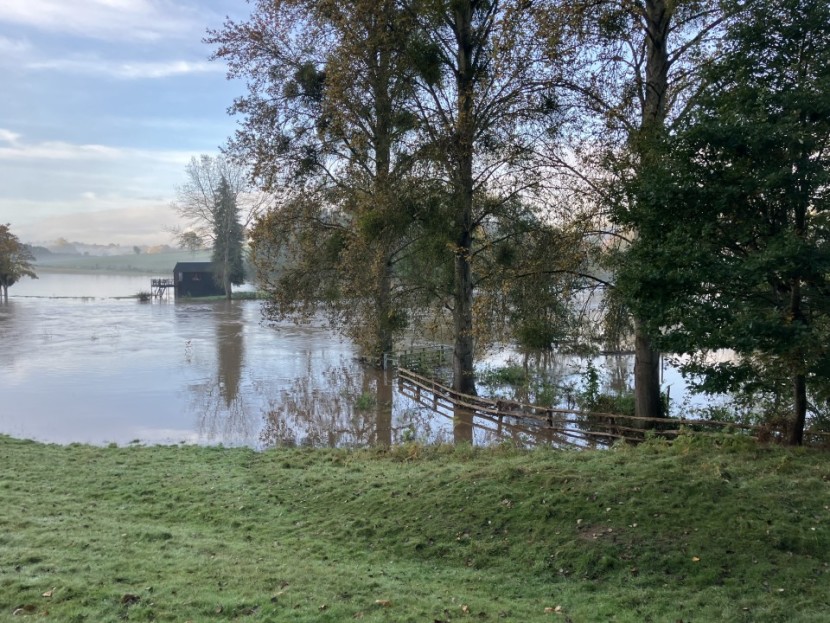 How Caple Court - LS from Stevenage
How Caple Court - LS from Stevenage 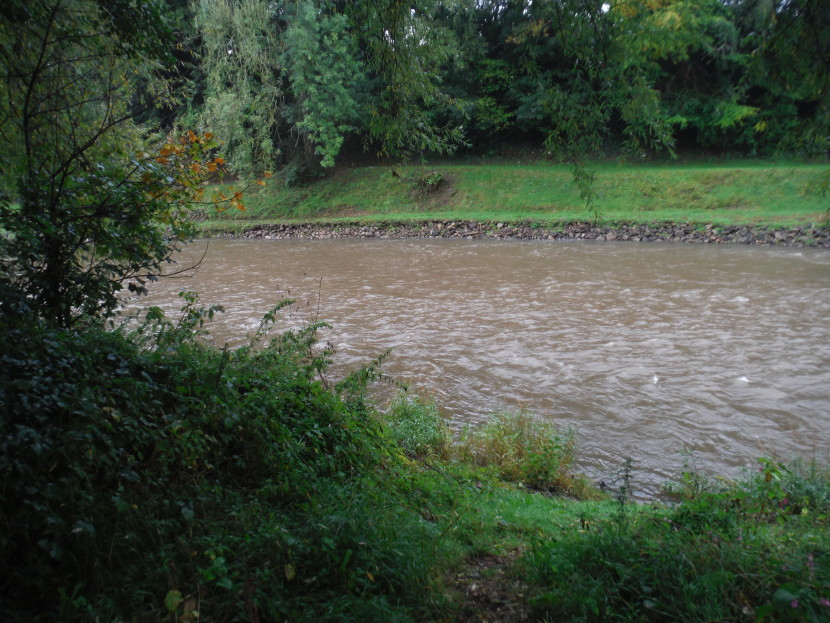 Lower Usk running muddy
Lower Usk running muddy While we were enjoying brief sunshine over the weekend, heavy rain in the Balkans was causing the worst floods in living memory, particularly in Bosnia and Herzegovina. It was strange to see a pretty little country town like Jablanica, which I used to know well, being featured now on the international news The great Neretva, a river which I always think of as green, was raging now like a tawny wild beast, despite the series of hydro-electric dams which one imagines might have tamed the flow. Most of the damage and indeed most of the deaths reported were caused by mud-slides in the side valleys. The lower parts of Jablanica town washed away together with the main road while the Mostar to Sarajevo railway was divided by a newly formed ravine, the metal tracks left hanging high in the air. Herzegovina has thus for now been cut off from Bosnia, both by road and by rail.
Looking back 30 years, Jablanica in one particular sense had an easy war. It was never shelled, this due to the shape of the mountains protecting it close above. Also, even in wartime you could get a lamb here. On International Women’s Day, March 8th 1995, we piled 20 women workers from the bakery in Mostar onto a couple of Bedford trucks and brought them up here for lunch. Mostar people are not without resources and we supplied the bread and wine. After three years of war, a party cheered everybody up.
After the Dayton Agreement at the end of the year the little town became once more a way-point for peace-time travellers on the road to Sarajevo. Here you traditionally stopped to eat roast lamb with salad and wine. There was a line of restaurants in the main street of Jablanica, each one with a lamb turning on a water-driven spit. If you didn’t have time for roast lamb, further along at Ostrozac you might stop at the baker to buy a warm half loaf generously spread with kaimak sour cream, before going on to Konjic and over the mountains to Sarajevo. With the new peace and spring sunshine, other well-remembered roadside characters began to show up: the old man who sells hand-carved wooden tobacco pipes; the lady with piled up jars of honey; the school kids offering wild strawberries when cars slowed down at hair pin bends. So charming is the valley here that while Paddy Ashdown was High Representative for Bosnia he bought privately a house and land for his family by the lake. The death toll at Jablanica and Ostrozac currently stands at 21, with more reported missing. The Civil Protection organisation is working to clear the debris while EUFOR, the small remaining international peace-keeping force, stands by to assist, if necessary with helicopters.
A few days after, Hurricane Milton hit Florida, making us all surely grateful that in Britain we don’t live in the path of that kind of weather. Yet another round of drastic floods in Spanish Valencia at the end of the month made me wonder if perhaps, now, we do?
 Konjic above Jablanica copy
Konjic above Jablanica copy  Neretva bridge copy
Neretva bridge copy 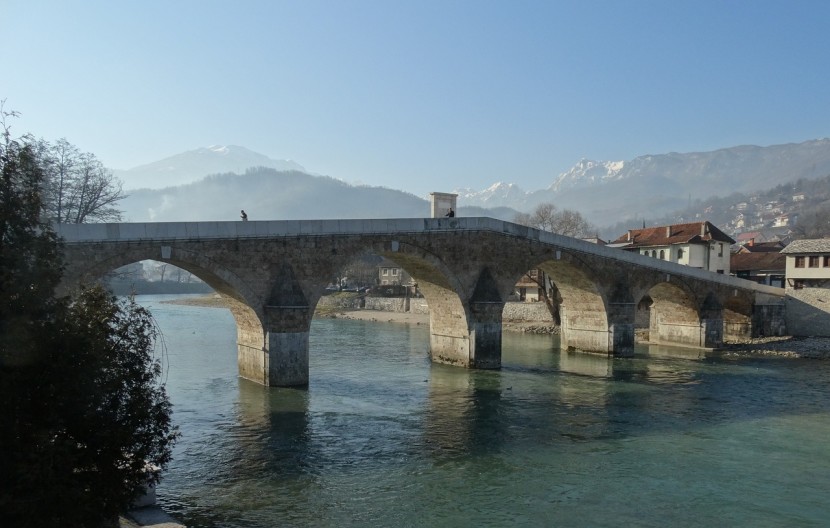 Neretva valley
Neretva valley 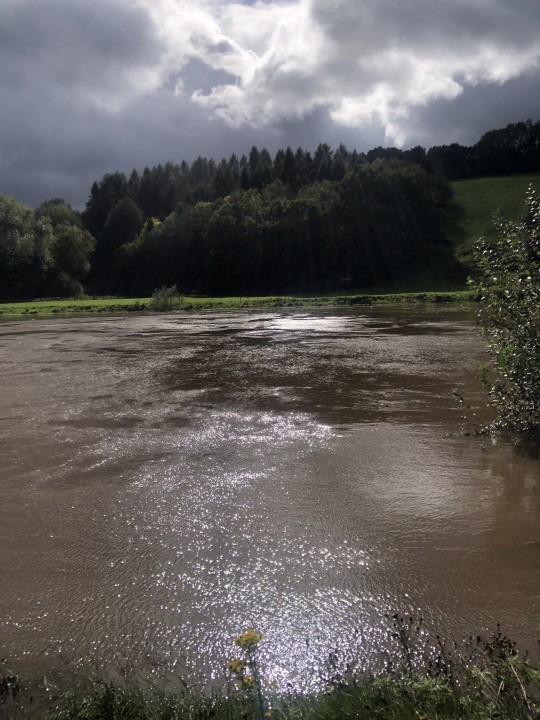 Whitney Court - AM from Romford
Whitney Court - AM from Romford Back to our British border rivers where much more modest flood water was slowly declining. AW from Salisbury reported from Eyton on the 4th, with the Lugg still running dirty. The level at Byton was 0.65, which really still counts as a flood and this tributary only comes down very slowly indeed. AW was baffled in his attempt to get practical fishing access with the additional problem of the closed footbridge; worse still, he believes he may have left his Greys 7ft 3 weight rod behind. Anybody finding this, please contact the Foundation.
PS from Stroud reported 7 chub, 2 roach and 9 dace at Whitehouse and also that he was inconvenienced by muck from cows on the access track which found its way onto his vehicle’s carpets. I sympathise, but this is a working farm and you should have a look at my carpets sometime! Everybody says that I treat my car like a tractor – it does get serviced, though! On the matter of the additional angler encountered on the Croy Pool, you can see from the website that there are 4 rods available here. If you need exclusivity, you have the option in some cases to block-book or buy all the tickets, although, speaking personally here, that slightly selfish exercise of financial power never seems to me to be very generous to your fellow anglers. If you think another angler is perhaps not entitled to be there, the way to proceed is to greet him cheerily, show him your ticket and ask to see his.
MG from Swindon had 5 barbel and 4 chub fishing Middle Ballingham and Fownhope No 8. IH from Poole had an interesting day of float fishing at Lower Cannon Bridge, catching 1 barbel, 10 chub, 2 roach, 1 perch and 10 dace. KS from Spalding caught 5 chub at Whitney Court on 5th October, but mentions that he was told by the keeper only shortly before fishing that no maggots are permitted there. As KS points out, that policy contravenes the list of by-laws and rules published with the beat details, so the matter really should be resolved by WUF with the owner. We have by-laws which are given to us from on high and additional rules which may be added by the owner, but I agree with KS that both should be made clear by the published description.
All that weekend we had been waiting for news of salmon as conditions seemed about right. Not much happened, however. Brian Skinner of Brecon, an experienced and enthusiastic salmon angler, reported rather glumly that he had fished both rivers hard over a week, but seen nothing. Then on the Saturday Roger Plowden of Midland Fly Fishers fished just above Glasbury Bridge on the Spreadeagle beat and caught two: a 9 pounds hen from the Grange and a cock fish of 90cm from Adams Catch. Nigel Smith had a hen fish of 14 pounds, also from the Grange, fishing with a Cascade on the Sunday, while Spencer John recorded a hen of 12 pounds on a Red Francis from the Usk.
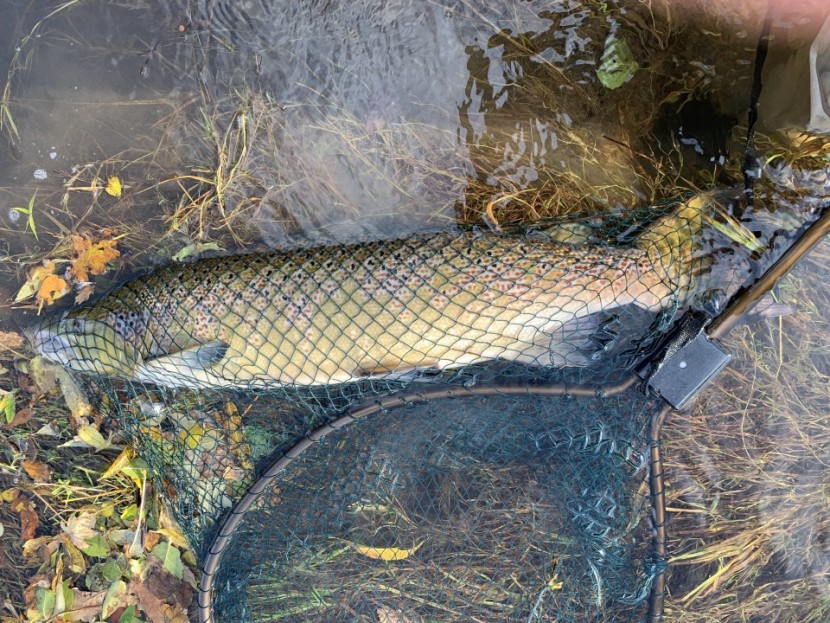 Spread Eagle - RP from Midland Fly Fishers
Spread Eagle - RP from Midland Fly Fishers 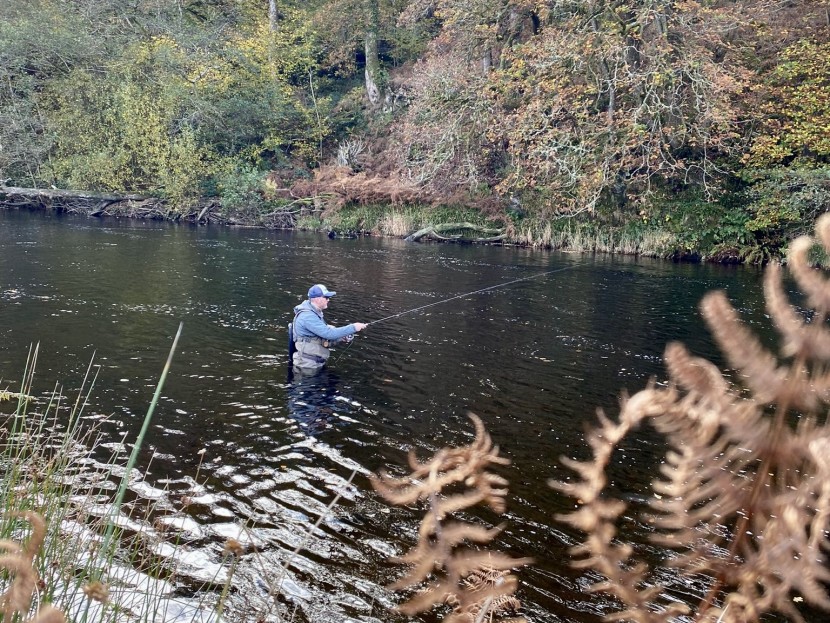 Craig Llyn - Lyn Davies
Craig Llyn - Lyn Davies After very heavy rain on Sunday night I reached the lower Usk at Kemys Commander just after dawn on Monday to find the river at a reasonable height but now colouring quickly from a flooding tributary somewhere upstream. Before it all became too thick I had a quick go down the pool with a sink tip and a tube fly and towards the end got a handshake, in other words a quick double pull plus a buzz from the reel check. A boil of smooth water came spreading up to the surface but the fish didn’t stick, nor would it come again, either to subsequent casts or while backing up. I left a few casts later as the water was becoming thicker minute by minute and a late cooked breakfast seemed more attractive. That’s a disgraceful lack of commitment on my part, some might say!
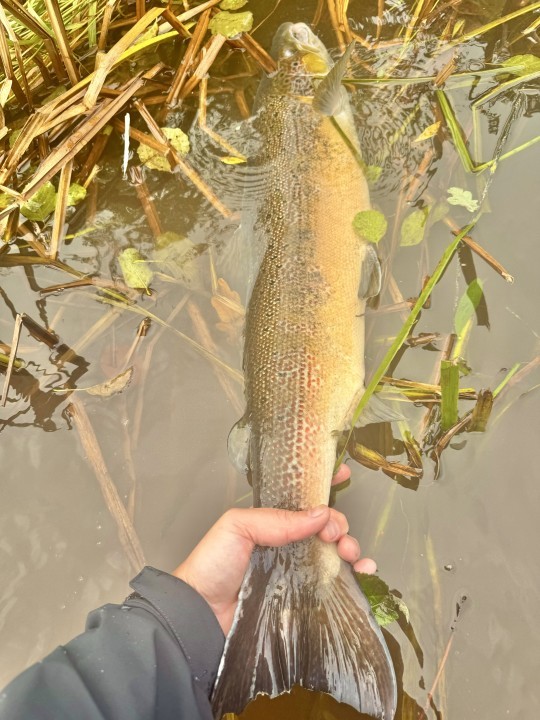 Chainbridge - Robert Davies from Chepstow
Chainbridge - Robert Davies from Chepstow That same morning, a mile upstream on the Chine Pool at Chainbridge, Roger Davies from Chepstow judged the colour too thick for fly-fishing, but got a cock fish estimated at 8-10 pounds with a spinner. About this time and very inconveniently the EA gauges for the lower Wye simultaneously began failing to transmit their water levels to the net. This lack of information was very bad timing for wet weather at the end of the salmon season but, take it from me, the water was high, rising and very richly coloured. DH from Horsham after fishing at Sugwas Court reported 6 barbel, 5 chub, and another sea trout. On the 9th MH from Chard fishing alone caught 16 barbel and 3 chub from Upper Hill Court and remarked that a dog spike was essential for getting up and down the banks. PC from Coleford with a friend reported 14 barbel and 2 chub from Wyastone Leys: “Fantastic fishing on a rapidly rising river…a great day all round.” DW from Bushey fished the Eyton Beat with the Lugg in flood, caught 5 grayling, and reminded us again that – as the fishing notes make clear – the footbridge in the middle of the beat has been declared unsafe and has therefore been blocked off. In low water, most anglers will find a crossing point to wade over, but in high water that will likely not be possible, effectively making this into a single bank fishery. On reflection it would be nice if somebody would get round to fixing the bridge, which would please walkers as well as anglers, for there is a public footpath across the river here.
Out for the day with a novice angler on the 12th, I was reminded of one out of many valuable pronouncements Reg Righyni made on the subject of grayling fishing. There is plenty of grayling literature available to us of course. Pritt, Walbran, Carter Platts, Rolt all wrote about the species, followed by modern writers such as Broughton and Roberts, but in my opinion Righyni truly was the father of this branch of our sport and that slim volume of his, Grayling, is worth reading again and again. This particular pronouncement was that the main charm of grayling is that, even on a really difficult day, they will almost always oblige at some point, even if it is just before dusk. Righyni made a very detailed study of “the way of a grayling with a dry fly” to the extent that I would argue that there is very little more to say on the subject, although European-style nymphing was of course unknown to him.
This particular autumn day for us on the Wye was one of the difficult ones, with the water high but clear, lots of leaves coming down and following quite a dramatic temperature drop overnight. The wind was cold and from the north. We worked hard all day with dry and wet flies, but with nothing much to show for it in the leaf soup except out of season trout on spiders, and we saw almost no fly life. And then, in the last hour, on fast running shallows maybe 20 inches deep, we saw a few dimpling rises as a grayling shoal began to feed. There were a few willow flies around by now which may have been the explanation. By standing off to one side we were able to make some offerings and see how the fish reacted. We were using old-school grayling patterns in size 16 and 18 and it was noticeable that a fly properly dry, standing up on its hackle points, was much more acceptable than a half-submerged fly, and also that fishing down and across to the risers, so that the fly preceded the tippet down the stream, was more successful than fishing up. There was a necessity to change patterns now and then as the grayling became accustomed to one which had caught or pricked a few, so we swapped around between Grayling Steel Blue and Sturdy’s Fancy. Righyni would have loved all this! I can’t claim that we made a huge bag because it was the first day of fly-fishing for my guest and he missed a good number on the strike. Nevertheless, his best fish was a very acceptable male of 17 inches. It all came to an end with torrential rain at 5 o’clock.
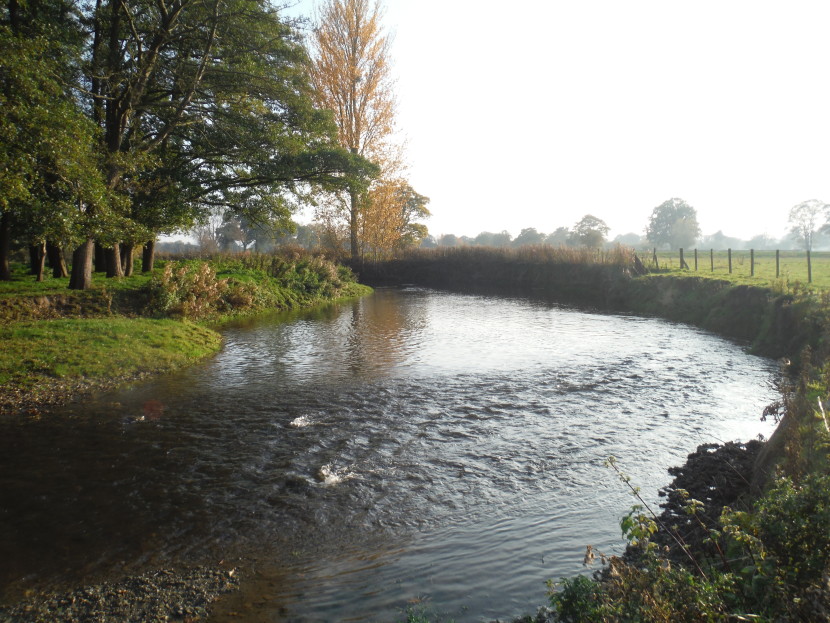 Eyton shallows
Eyton shallows 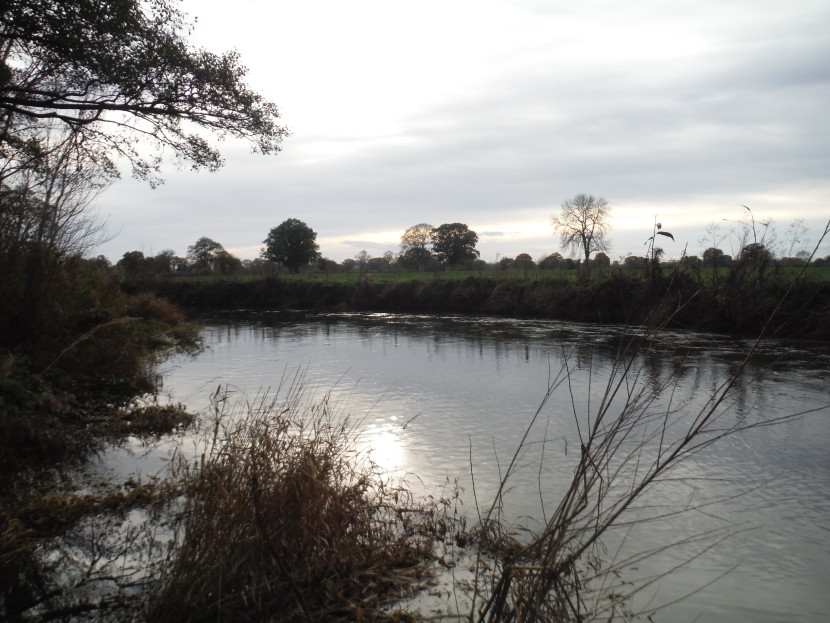 Lugg at Eyton
Lugg at Eyton We never saw a salmon moving during that whole day although the water level looked about right and a rather disconsolate salmon angler came wandering past. One salmon angler who did not wait in vain was William Morley, who on the same day caught a cock fish of 25 pounds at Glanwye. That will certainly be one to remember. The Wye was now slightly on the rise again, the land being so saturated that any rain falling had an immediate effect. We heard that Abercothi on the Towy now had 12 salmon recorded for October, so we felt distinctly jealous of the neighbouring river. Up at Pond Rhrosrydd, which is open for stocked trout until 17th October, MC from Desborough recorded 6 fish. AD from Exeter was distinctly pleased to record 48 grayling from Abernant. Brian Skinner from Brecon then broke a long fast with a salmon of 13 pounds taken with one of his home-tied Waddingtons in the Rock Pool of the Rectory. GO from Brecon lost a nice fish in the Chapel Stream of Llangoed; DC from Mountain Ash lost another hooked on a Silver Doctor. It all went better for Chris Ryan of Talgarth at the Nyth, where he took two salmon with a sink tip and a Willie Gunn tube: a 14 pounds cock from the Cafn neck and a 12 pounds hen from Cafn Stream. There was another of 11 pounds from the Kitty Pool on the 15th.
16th October was a strange day, suddenly warm after very heavy rain overnight. Nerma and I drove up-river for shooting practice at Upton upon Severn beside an estuary brimming full on a high spring tide, but with heavy mist rising to join threatening low clouds. This made the whole scene strangely dark and the nearby Malvern Hills were quite invisible. We got our 100 targets launched, duly hit some and missed others, but escaped just before the threatened rain came pouring down. When it did, so wet was the ground everywhere in the Marches that the middle Wye quickly burst its banks and all the tributaries rose in flood. This would eventually result in a 3 metre rise. The Severn followed a day later. Most coarse anglers gave up when confronted with floods which were clearly becoming dangerous, but a few got decent catches just as the river rose. Reports included such comments as:“This was the day the rains came,” “…rain of biblical proportions” and “Rising river turned the fish on”. TD from Chelmsford with a friend had 8 barbel to 11 pounds 5 ounces at Fownhope no 5, while AM from Dorchester with 3 companions fished at Wyastone Leys for 9 barbel to 9.5 pounds.
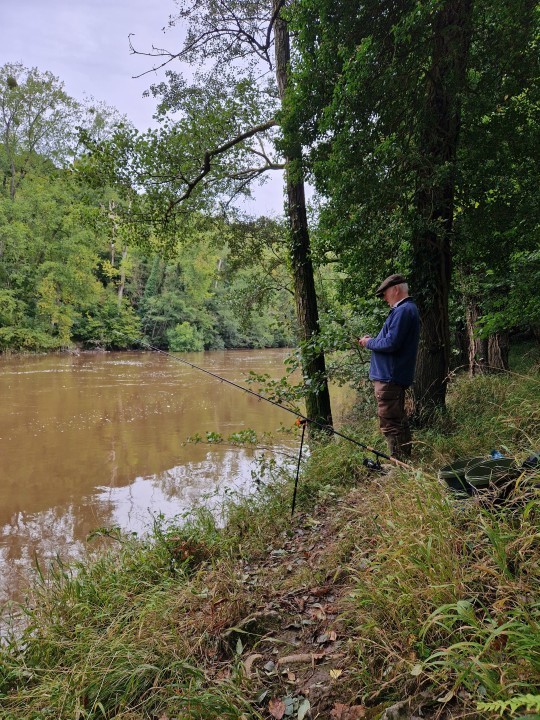 Lower Symonds Yat - JC from Harpenden
Lower Symonds Yat - JC from Harpenden 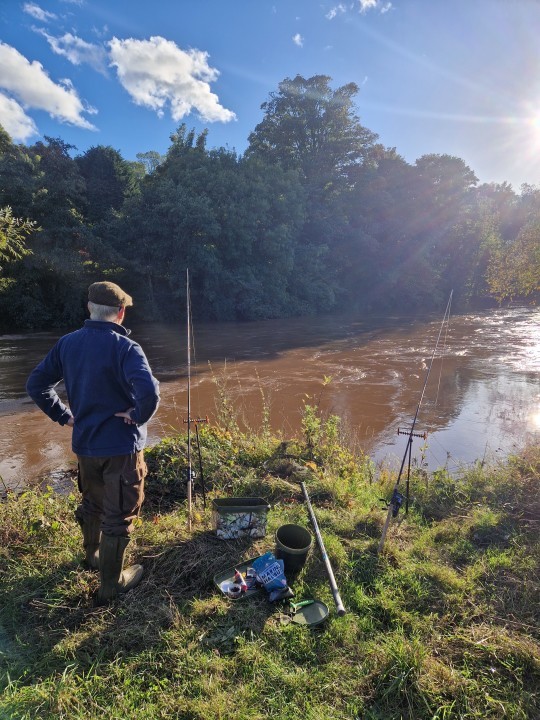 Home Fishery in flood - JC from Harpendon
Home Fishery in flood - JC from Harpendon The 17th dawned bright and clear, but the muddy floods now in the rivers put an end to the last day of the salmon season and practically anything else game anglers on moving water may have had in mind. The EA had flood alerts in place for much of the low lying area beside the middle and lower Wye as the water came over the fields and onto the roads, and even the tributaries provided no fishing opportunities. We learned that Nyth and Tercelyn now had 17 salmon in the book for their season; from the Rocks, 10; and Lower Glanwye, 4. A final report came in from Abercothi on the Towy: 15 for October and 59 for the season. The Towy is generally known as a late running river but it seems to have fared better than the Wye or Usk this year. A friend was somewhat upset to have lost a nice looking fish on the Loughor, also on the final day.
 Lyepole - KM from Hereford
Lyepole - KM from Hereford Many coarse anglers also had to give up their plans, but some did manage to find a place to fish. On the 18th CM from Ware with 3 friends fished at Home Fishery “…until water came up further and we made a tactical retreat.” They did manage to catch a barbel of 12 pounds 2 ounces. The same group tried Middle Hill Court on the 19th and caught 13 barbel after the water receded from the fields a little. T from London found the Trelough Pool discoloured, but caught three carp to 23 pounds 8 ounces before dark. The 20th was the day of Storm Ashley, which whipped up the wind and filled many waters with a sort of soup of fallen leaves, but didn’t add anything much to river levels. AH from Whitney with a friend caught 11 barbel to 10 pounds at How Caple Court and Ls from Stevenage with a friend reported 14 barbel and a chub from the Creel. GM from Coventry with a companion caught 9 barbel and 11 chub at Upper Hill Court. The relatively warm water temperatures for late October were seemingly keeping the barbel’s interest in feeding engaged. Always bearing in mind that most of our barbel fishing visitors stay for 2 or 3 days, thus making a welcome contribution to the local economy, DP from Lutterworth had a hearty recommendation for the Falcon House B&B at How Caple.
By the 24th, with the Wye levels still falling, AG from Gosport reported 3 barbel and 12 chub from Sugwas Court. TD from Axbridge pronounced himself very pleased with a barbel of 10 pounds 11 ounces taken at How Caple Court. AG from Harleston, Norfolk, one of our regulars for grayling, reported 19 of these classic autumn and winter fish from the Glyndwr Preserve of the Welsh Dee. The Irfon gauge at Cilmery was now reading 0.6 metres, about the maximum for practical fly-fishing. Only the upper beats of this tributary were available because of the crayfish plague measures; PJ from Swansea Vale fishing the Colonel’s Water reported no less than 16 out of season trout, but a blank for grayling, which is discouraging. TP from Woodbridge managed 11 grayling from the Ithon Severn Arms No 1 beat, mainly by heavy nymphing, but had serious questions to ask about access to the bottom end, arguing that the map issued to anglers is inaccurate as it shows fishing rights from what are in fact people’s gardens, and that some sections are blocked off with barbed wire. The WUF is discussing this with the fishery owner, but TP suggests for now that visiting anglers start from the top end of this beat. AP from the Wirral was one of the first this year to try winter trotting at Abernant, but was disappointed to catch 30 out of season trout and no grayling at all. On the 28th KC from Leeds caught 2 barbel and 16 chub from Middle Ballingham and Fownhope No 8. KM from Hereford had half a dozen nice grayling tight line nymphing on the Lugg at Lyepole. RL from Chelmsford reported 5 barbel and 46 chub from Sugwas Court. AT from Basingstoke reported 10 barbel to 8 pounds 12 ounces and 2 chub from Thomas Wood. Finally OS from Darlington caught a salmon from the Raby Estate water of the Tees on the 29th. I had forgotten that this one is open for salmon fishing until the end of October. And, believe it or not, OS reported a second one on the 30th.
Thankfully the Beacons Reservoirs were fishing better now that the weather had cooled and most anglers had satisfactory catches. However, MJ of Cardiff who had 5 rainbows on worm had yet another complaint about Llwyn On: “Obvious signs of night fishing / poaching on both banks but bailiffs say they will not confront these people at all. If that is the case then Welsh Water obviously have no intention at all to stop it, which is terrible from them given the cost to us to fish there legally.” Which bailiff has said this to MJ? We see a lot of reports of this kind, and the WUF do assure me that they are shared and discussed with Welsh Water. The only advice I can give is that in the case of hard evidence of illegal behaviour – and I don’t mean rumours or suspicions or a vague feeling that bailiffs aren’t doing their job – that you use your phone to contact the authorities at once, there and then, with full details of what you see and know. In the case that a sort of chaotic atmosphere persists around the Beacons reservoirs, sooner or later we will probably lose the fishing.
Here’s another video from Lyn Davies, this time of a late September trip for wild trout to the Crai Reservoir in the Brecon Beacons. Conditions were about perfect with clouds, soft light and a steady ripple. Rainbow trout anglers in the habit of putting a bag of tackle down on a likely looking spot and sticking to fishing it for a while should note the amount of shore-line Lyn covers during the day, using both wet and dry flies. You do need to go looking for wild brownies:
Welsh farmers tend to talk a lot these days about the pressure put on them by government about slurry spreading and slurry storage. We all know about cases of damage to rivers caused by careless spreading; currently we are in the first weeks of the annual closed season regulated for spreading and farmers are supposed to have facilities for storing slurry for 5 months if needed. The present wet weather has made this difficult so that many are complaining to government that the requirements are unreasonably onerous and “farming by calendar is not practical.” For an article on the subject see the Afonydd Cymru website.
I was sorry to read about the death this month at 80 years old of General Sir Mike Jackson, who had retired as Britain’s senior soldier, Chief of the General Staff. Along with American General Eric Shinseki, he was one of the few military commanders who criticised the lack of political planning in the US and the UK for the aftermath of the 2003 Iraq invasion. His career, apart from his final and valuable work restructuring the British Army, led him through Russian studies at Birmingham University, the Intelligence Corps and the Parachute Regiment, to Northern Ireland where he was present at Bloody Sunday, Staff College, and on to a year as a two star general commanding Multinational Division South-West in IFOR. This was the first phase American-led NATO force implementing the Dayton Agreement in Bosnia. I never met him then as I was working in the northern sector, although I wish I had, but in June 1999 at the end of the Kosovo War he had become a three star and commanded the Allied Rapid Reaction Corps. This position was under the overall command in KFOR of American four star General Wes Clark, who was then the Supreme Allied Commander Europe. (For those who don’t know, the US almost always insists on an overall American commander for NATO expeditions of this kind. During the same period in Bosnia’s SFOR, the stabilisation force following on from IFOR, we had the pleasure of US General Montgomery Meigs).
My own office at the time was in Zvornik, north-eastern Bosnia, right on the border with Serbia which I could see from the window across the River Drina. In 1999 I was working for the High Representative and busy with the return of refugees and reconstruction. In the south of my patch, I related to American forces in SFOR, based on Eagle Base at Tuzla airfield. In the north of my patch, I related to Russian 1st Separate Airborne Brigade based a few miles away at Ugljevik. (And for those who have forgotten, this was one occasion when Russian forces served under American/NATO command). The Russian Brigade officers, nearly of all of who were Afghanistan veterans, were initially dubious about the return of the expelled Muslim population to their AOR which my job implied. To begin with, when Bosnian Muslims returned to their destroyed villages in Zvornik, the Russians pointedly withdrew their patrols. However, we got over that problem and I like to think that I had a better relationship with my local Russian forces than the Americans at Tuzla could claim. The relationship had involved a certain amount of vodka and patience, plus one very extended and memorable lunch on the terrace of the Vidikovac Hotel overlooking Zvornik Lake. The generally held view of the Russians about their own situation was that a posting in Bosnia was much better than one to Chechnya. Plus, once deployed in the Balkans, there was always the possibility of buying a used Mercedes of dubious provenance and shipping it back to Omsk, or wherever. Meanwhile, some of the American officers based at Tuzla could have made them more welcome. On the other hand again, my friend the American political adviser there, himself a Vietnam vet and former marine, used to tell me that everything involving the Russian force had become noticeably more difficult since Putin had taken power in Moscow as Prime Minister. At the same time Serbs in both Bosnia and Serbia proper always looked on the Russians as natural allies. I certainly do recall that the Kosovo crisis was a nervous time for everybody in the Serb-controlled part of Bosnia. A Serb jet sent to attack Tuzla was shot down. The NATO air raids on Belgrade had now stopped while KFOR ground forces were moving in to control territory in Kosovo. Obviously control of the airport in Pristina was a key objective for KFOR, and perhaps for others.
What happened next was remarkably quick and certainly caused some surprises. Russian Separate Airborne Brigade painted out the S for SFOR on some of their eight-wheeled transporters, substituted it with K for KFOR, crossed the border from Bosnia into Serbia and sped down the motorway, presumably by invitation of the Serbian authorities. Within a few hours they had crossed into Kosovo and established control over Pristina airport. Wes Clark was reportedly furious and ordered Mike Jackson to kick them off or at least block the runways so that reinforcements could not be flown in from Russia, which was certainly a scenario being imagined at the time. Mike Jackson’s response to Clark, thankfully, was said to be: “Sir, I’m not going to start the third World War for you.” Importantly, London backed him up. Jackson went off with a bottle of whisky to see the Russian commander on the airport, found that the Russians were in fact now slightly nervous about being attacked by Albanians of the Kosovo Liberation Army and offered that a detachment of British parachutists commanded by his own son would help secure their perimeter. In my experience this was the sort of approach generally appreciated by Russians. You could imagine the conversation over a glass between two experienced airborne soldiers. The crisis passed away and the airport was made available to the whole of KFOR.
I wish I had seen some of that, but I was at the next Monday morning meeting at the American base back in Tuzla and watched the delegates from Russian Separate Airborne Brigade arrive to take part as usual. They were grinning from ear to ear. It was quite a moment! When I finally left Bosnia, the Brigade gave me their parachutist’s blue beret and blue and white striped undershirt as a memento – sadly to be lost somewhere in my travels over the years.
Next month when the final tallies come in we should take a review of the 2024 salmon season for our rivers, but the result has surely not been very encouraging. It’s around 200 for the Wye as it stands, maybe 100 on the Usk. Meanwhile, game fishers should have grayling fishing to look forward to – although at the time of writing most beats of the Irfon and the Arrow tributaries are not available because of the crayfish plague problem.
Tight lines when you get a chance!
Oliver Burch
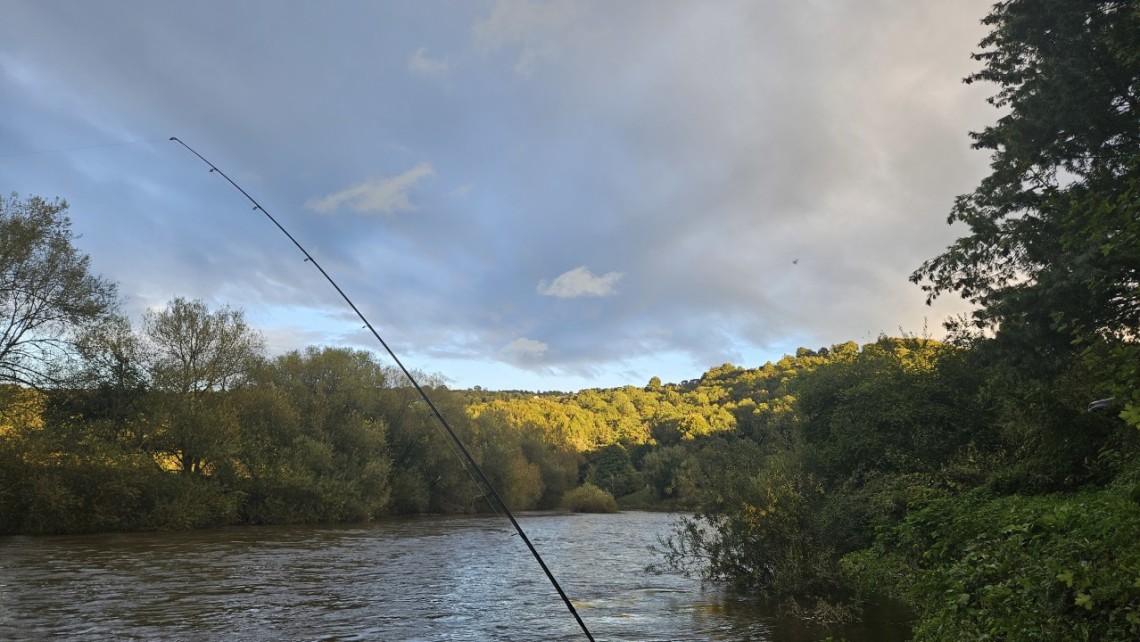 Wyebank - TW from Bishops Offley
Wyebank - TW from Bishops Offley